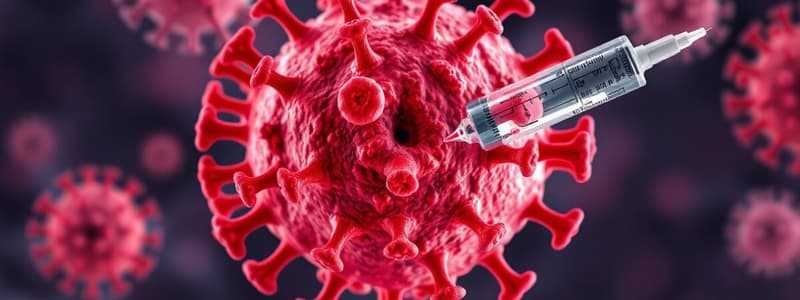Podcast
Questions and Answers
What is a critical requirement during exposure for protective immunity against microorganisms?
What is a critical requirement during exposure for protective immunity against microorganisms?
- Increased T-cell population
- Development of new antibodies post-exposure
- Presence of preexisting antibodies (correct)
- Immediate vaccination after infection
Which of the following is a characteristic of effective vaccines?
Which of the following is a characteristic of effective vaccines?
- Produces long-term immunity (correct)
- High likelihood of causing side effects
- Requires repeated vaccinations annually
- Always results in high patient compliance
What is a consequence of an ineffective T-cell response during vaccination against the respiratory syncytial virus?
What is a consequence of an ineffective T-cell response during vaccination against the respiratory syncytial virus?
- Development of neutralising antibodies
- Induction of harmful inflammation (correct)
- Strengthening of adaptive immune memory
- Enhanced immunity against future infections
Why can children under 2 years of age not be effectively vaccinated with polysaccharide vaccines?
Why can children under 2 years of age not be effectively vaccinated with polysaccharide vaccines?
What is the aim of using conjugated vaccines for bacterial infections?
What is the aim of using conjugated vaccines for bacterial infections?
What role do adjuvants play in vaccines?
What role do adjuvants play in vaccines?
What is the significance of using capsular polysaccharide harvesting from bacterial growth medium in vaccine development?
What is the significance of using capsular polysaccharide harvesting from bacterial growth medium in vaccine development?
How does the presence of T-cell independent antigens affect vaccine effectiveness in young children?
How does the presence of T-cell independent antigens affect vaccine effectiveness in young children?
What is a crucial characteristic of live-attenuated bacterial vaccines regarding the mutated bacteria?
What is a crucial characteristic of live-attenuated bacterial vaccines regarding the mutated bacteria?
Which of the following represents a disadvantage of live-attenuated vaccines?
Which of the following represents a disadvantage of live-attenuated vaccines?
What is the outcome of mutating wild-type bacteria like Salmonella typhi using nitrosoguanidine?
What is the outcome of mutating wild-type bacteria like Salmonella typhi using nitrosoguanidine?
What method is currently being explored to enhance the effectiveness of bacterial vaccines?
What method is currently being explored to enhance the effectiveness of bacterial vaccines?
What mechanisms does the Sabin polio vaccine utilize to induce protective immunity?
What mechanisms does the Sabin polio vaccine utilize to induce protective immunity?
What mechanism do dendritic cells primarily use to capture antigens from the environment?
What mechanism do dendritic cells primarily use to capture antigens from the environment?
Which type of vaccine is considered more potent in eliciting CD8 T cell responses due to its replication capabilities?
Which type of vaccine is considered more potent in eliciting CD8 T cell responses due to its replication capabilities?
What is the primary risk associated with administering live-attenuated vaccines to immunodeficient patients?
What is the primary risk associated with administering live-attenuated vaccines to immunodeficient patients?
Which of the following best describes the role of cytokines secreted by activated dendritic cells?
Which of the following best describes the role of cytokines secreted by activated dendritic cells?
What is the significance of T-cell peptide epitopes in vaccine development?
What is the significance of T-cell peptide epitopes in vaccine development?
Which approach is NOT a suggested solution for enhancing the immunogenicity of synthetic peptides in vaccine development?
Which approach is NOT a suggested solution for enhancing the immunogenicity of synthetic peptides in vaccine development?
What is one of the major challenges in generating an MHC class I specific response with synthetic peptides?
What is one of the major challenges in generating an MHC class I specific response with synthetic peptides?
How do opportunistic pathogens differ from virulent pathogens in immunocompetent individuals?
How do opportunistic pathogens differ from virulent pathogens in immunocompetent individuals?
What is the primary function of the muramyl dipeptide derived from mycobacterial cell walls?
What is the primary function of the muramyl dipeptide derived from mycobacterial cell walls?
Which MHC variant is associated with resistance to cerebral malaria as noted in population studies?
Which MHC variant is associated with resistance to cerebral malaria as noted in population studies?
Which of the following statements correctly reflects the risk of attenuated viral vaccines?
Which of the following statements correctly reflects the risk of attenuated viral vaccines?
What role do immune stimulatory complexes (ISCOMs) play in vaccine development?
What role do immune stimulatory complexes (ISCOMs) play in vaccine development?
What is the importance of cytokine GM-CSF in dendritic cell activation?
What is the importance of cytokine GM-CSF in dendritic cell activation?
What form of vaccine typically uses live-attenuated organisms to induce immunity without causing disease?
What form of vaccine typically uses live-attenuated organisms to induce immunity without causing disease?
Flashcards
Protective Antibodies
Protective Antibodies
Antibodies targeting multiple parts of a pathogen, but only some provide protection.
Vaccine Efficacy
Vaccine Efficacy
The ability of a vaccine to stimulate an immune response that protects against disease.
Conjugate Vaccine
Conjugate Vaccine
A type of vaccine where a polysaccharide capsule is attached to a protein carrier.
Adjuvant
Adjuvant
Signup and view all the flashcards
Herd Immunity
Herd Immunity
Signup and view all the flashcards
Antitoxin Antibodies
Antitoxin Antibodies
Signup and view all the flashcards
T-cell Independent Antibody Response Limitation
T-cell Independent Antibody Response Limitation
Signup and view all the flashcards
T-cell Dependent Immune Response
T-cell Dependent Immune Response
Signup and view all the flashcards
In vitro Mutagenesis for Vaccines
In vitro Mutagenesis for Vaccines
Signup and view all the flashcards
Live-Attenuated Vaccines
Live-Attenuated Vaccines
Signup and view all the flashcards
Live-Attenuated Salmonella Vaccines
Live-Attenuated Salmonella Vaccines
Signup and view all the flashcards
Auxotrophic Bacteria in Vaccines
Auxotrophic Bacteria in Vaccines
Signup and view all the flashcards
Live-Attenuated Polio Vaccine
Live-Attenuated Polio Vaccine
Signup and view all the flashcards
Freund's Complete Adjuvant
Freund's Complete Adjuvant
Signup and view all the flashcards
Muramyl Dipeptide (MDP)
Muramyl Dipeptide (MDP)
Signup and view all the flashcards
Dendritic Cells (DCs)
Dendritic Cells (DCs)
Signup and view all the flashcards
Antigen Uptake
Antigen Uptake
Signup and view all the flashcards
DC Migration
DC Migration
Signup and view all the flashcards
Co-Stimulatory Molecules
Co-Stimulatory Molecules
Signup and view all the flashcards
Immune Stimulation
Immune Stimulation
Signup and view all the flashcards
T-cell Epitopes
T-cell Epitopes
Signup and view all the flashcards
Immunogenicity of T-cell Epitopes
Immunogenicity of T-cell Epitopes
Signup and view all the flashcards
Synthetic Peptide Approach
Synthetic Peptide Approach
Signup and view all the flashcards
Reverse Immunogenetics
Reverse Immunogenetics
Signup and view all the flashcards
Live-Attenuated Viruses
Live-Attenuated Viruses
Signup and view all the flashcards
Recombinant DNA Technology
Recombinant DNA Technology
Signup and view all the flashcards
Inactivated Vaccines
Inactivated Vaccines
Signup and view all the flashcards
Potency of Live-Attenuated Vaccines
Potency of Live-Attenuated Vaccines
Signup and view all the flashcards
Study Notes
Effective Vaccine Mechanisms
- An effective vaccine requires the presence of pre-existing antibodies upon exposure for protective immunity against microbes. For example, pre-existing antibodies against bacterial exotoxins are necessary for protection against the disease.
- Immune responses produce antibodies targeting multiple pathogen epitopes, but only a subset provides protection.
- Early vaccination against respiratory syncytial virus (RSV) elicited T-cell responses, leading to inflammation but no neutralizing antibodies and pathologic effects without protection.
Vaccine Requirements
- Effective vaccines induce:
- Antibody generation
- T-cell targeting of correct pathogen epitopes
- Vaccine constraints:
- Safety: Must be safe for large-scale administration with minimal infections.
- Protection: Must provide protective immunity to the majority.
- Long-term effects: Protection should last years.
- Affordability: The vaccine should be cost-effective for broad population use.
Conjugate Vaccines
- Conjugate vaccines are effective against bacteria with polysaccharide antigens (e.g., Neisseria meningitidis, Streptococcus pneumoniae, Haemophilus influenzae).
- The polysaccharide coating on these antigens hinders recognition and immune response in children.
- Effective defense: Antibody opsonization of the polysaccharide coat.
- Vaccination aims to produce antibodies against the bacterial capsule polysaccharide.
- Polysaccharide harvesting from bacterial growth mediums.
- T-cell-independent antigens are used for vaccines.
- Problem: Children under 2 cannot effectively produce T-cell-independent antibody responses and therefore cannot be effectively vaccinated with polysaccharide vaccines.
- Solution: Chemically conjugating bacterial polysaccharides to protein vaccines.
- Peptides can recognize specific T cells, converting T-cell-independent responses into T-cell-dependent anti-polysaccharide antibody responses.
Adjuvants
- Adjuvants enhance antigen immunogenicity.
- Example: Tetanus toxoid is not immunogenic, but tetanus vaccines include aluminum salts to bind and stimulate antibody responses selectively.
- Other examples include cells and parts of bacteria.
- Freund's complete adjuvant: In vivo use to modify antibody responses. Contains water-oil emulsion and killed mycobacteria.
- Muramyl dipeptide (a complex glycolipid): From mycobacterial cell walls, contains adjuvant activity similar to whole killed mycobacteria.
- Mechanism of action: Adjuvants act on antigen-presenting cells (APCs), primarily dendritic cells (DCs).
- DCs, detecting pathogens, take up antigens via phagocytosis, migrate to lymphoid tissue, and present antigens to lymphocytes.
DC Activation
- DCs detect pathogens in two ways:
- Direct: Activation by pathogen receptors (e.g., complement, Toll-like receptors).
- Indirect: Activation by inflammatory cytokines (e.g., GM-CSF) triggered by infection.
- Activated DCs secrete cytokines and express co-stimulatory molecules, activating and differentiating antigen-specific T cells.
- This mimics an active infection, stimulating an immune response.
Synthetic Peptides for Vaccines
- Synthetic peptides of protective antigens can elicit protective immunity.
- T-cell epitopes: Peptides from antigens, recognized by T-cell receptors (TCRs) bound to MHC molecules on APCs.
- Immunogenicity depends on the associated MHC molecules' polymorphic variants.
- Vaccine development techniques:
- Systemic synthesis of overlapping peptides from immunogenic proteins, testing each for protective immunity.
- Reverse immunogenetics: Examining populations for MHC molecule variants associated with resistance to a disease (e.g., HLA-B53 variant resistant to cerebral malaria).
Synthetic Peptide Limitations & Solutions
- Limitations:
- Synthetic malaria peptides may not be immunogenic in individuals lacking HLA-B53.
- MHC high polymorphism necessitates identifying proactive T-cell epitope panels for vaccine construction.
- Peptides are not strongly immunogenic.
- Difficult to generate MHC class I-specific responses by in vivo immunization with peptides.
- Solutions:
- Genetically engineering peptide integration into a carrier protein (e.g., viral factor) for better processing.
- Using ISCOMs (immune stimulatory complexes): Lipid carriers as adjuvants with minimal toxicity. Deliver peptides to cell cytoplasm, activating MHC I-restricted T-cell responses.
- Lipid micelles fuse with cell membranes, delivering peptides to the APC cytosol and binding to MHC I molecules.
Live-Attenuated Viral Vaccines
- Basic information: Use inactivated or live-attenuated viruses, with treated viruses unable to replicate.
- Live-attenuated viral vaccines are more potent, eliciting more effector CD8 T cells.
- Inactivated vaccines cannot produce proteins in the cytosol. Peptides from viral antigens cannot be presented by MHC class I, hindering CD8 T-cell production.
- Examples: Polio, measles, mumps, rubella, and COVID-19.
- Risks: Risk of immune-deficient recipients treating vaccine as virulent. Opportunistic and virulent behaviors in compromised hosts.
- Risks of live-attenuated virus use in immunodeficient infants: Increased disease possibility due to uncontrolled virus replication and chance of mutation.
Recombinant DNA Technology and Bacterial Vaccines
- Isolating and in vitro mutating specific viral genes, replacing wild-type genes in the virus. Generates reconstituted virus genomes.
- Live-attenuated bacterial vaccines (e.g., Salmonella typhi):
- Mutation of wild-type bacteria (e.g., using nitrosoguanidine) generates new strains.
- Defective enzyme: Blocks lipopolysaccharide synthesis.
- Recent approach: Targets genes coding for enzymes responsible for pathogenicity.
- Creating auxotrophic organisms: Mutated bacteria grow poorly in the gut without external nutrient supply, but still function as vaccines to induce effective immune response.
Route of Vaccination
- Injection (common) is often less effective and less popular.
- Development of mucosal vaccine delivery (oral, nasal inhalation) to better mimic natural pathogen entry.
DNA Vaccinations
- Injecting DNA encoding microbial antigens and human cytokines into muscles.
- Use nonreplicating bacterial plasmids encoding proteins for gene therapy.
Studying That Suits You
Use AI to generate personalized quizzes and flashcards to suit your learning preferences.
Description
This quiz explores the essential mechanisms and requirements for effective vaccines. It covers topics such as the importance of pre-existing antibodies, T-cell responses, and the constraints of safety, protection, long-term effects, and affordability in vaccine development. Test your understanding of how vaccines achieve protective immunity against various pathogens.






